Cactus di Fuoco's Blog, page 7
January 1, 2025
Pillola d'ispirazione 1. L'Epitaffio di Sicilo
 La canzone completa più antica ai trovata è l'Epitaffio di Sicilo, una bellissima canzone scritta nell'Antica Grecia sulla pietra, che celebra la vita e la gioia.Siccome sia il testo che la musica sono arrivati intatti al giorno d'oggi, puoi persino cercarla ed ascoltarla in degli arrangiamenti moderni!
La canzone completa più antica ai trovata è l'Epitaffio di Sicilo, una bellissima canzone scritta nell'Antica Grecia sulla pietra, che celebra la vita e la gioia.Siccome sia il testo che la musica sono arrivati intatti al giorno d'oggi, puoi persino cercarla ed ascoltarla in degli arrangiamenti moderni!La sua creazione è stata datata in maniera variabile tra il II secolo a.C. al II secolo d.C. I Canti Urriti sono persino più anyichi, ma sono, purtroppo, solo dei frammenti, lasciando dunque intatto il record di Sicilo.
IL TESTO
«Ὅσον ζῇς φαίνου·
μηδὲν ὅλως σὺ λυποῦ·
πρὸς ὀλίγον ἐστὶ τὸ ζῆν.
τὸ τέλος ὁ χρόνος ἀπαιτεῖ.»
TRASCRITTO
«Hòson zḕs, phàinū:
mēdèn hòlōs sỳ lypū̀;
pròs olìgon estì tò zḕn
tò tèlos ho chrònos apaitèi.»
TRADUZIONE
«Finché vivi, mostrati al mondo,
non affliggerti per niente:
la vita è breve.
Il tempo esige infine il suo tributo.»
December 30, 2024
Inspiration pills 1. Seikilos Epitaph

The oldest complete song ever found is the Seikilos Epitaph, a beautiful Ancient Greek song written in stone that celebrates life and joy.
Since both its words and music sheet have arrived intact to this day, you can actually learn and listen to the oldest complete song today!
It has been dated to have been created between the 1st or 2nd century CE.
The Hurrian Hymns are pre-dating even Seikilos Epitaph, but they are, alas, just fragments, so Seikilos' record still stands.
December 25, 2024
Aboletto [English version]

Abolettos(Lacrimae somniorum) are spirits belonging to the Lemures group. Inthe paralarval stage they are known, together with two other speciesof the same family (Lacrimae sanguinis and sidereum), as tearsof desires.Appearance
As adults, abolettos have the appearance of large spherical massestwo to six meters wide, generally flattened at the poles, green,yellow or blue in color, translucent enough to allow a glimpse of theluminous energy center, which is located right in the center of thebody.
They have no eyes or ears, si they orient themselves in the worldonly through taste, the perception of pain and that of vibrations.The surface of adult abolettos is soft and pleasant to the touch: thesensation of touching them has sometimes been described as similar tothat of a hot water bottle made of agar agar jelly.
During their paralarval stage, they tend to be brighter, with acrystalline surface, and gather in small colonies that, when theymanifest in the material world, are particularly pleasing to humans.
When an adult aboletto is injured, it protects itself by instantlyforming a series of long spines on its surface, giving it theappearance of a big sea urchin.
BehaviorAbolettos are extremely passive spirits, which simply remain inthe same spot even for years, incorporating dust and dead materialsthat touch them through their skin, feeding very slowly. They arecompletely harmless, except for the long spikes that form on theirsurface when they are injured, and due to their extremely elastic androbust consistency, they are difficult to cut or pierce, so thepossibility of being accidentally stung by their rising spikes isvery low.
They rarely manifest in the material world, and when they do, itis generally due to mistakes or the fault of other creatures thattransported them. When this happens, they have no problem survivingin the material world, feeding primarily on dust, dry leaves, deadinsects, and other things that settle and remain on them for a longtime.
HabitatAbolettos are an indicator of healthy and life-rich areas,thriving primarily within complex spirit ecosystems. Well-developedabolettos can generally be found wherever there are living forestswith large trees.
DietIn their natural environment, abolettos feed primarily onnon-encoded ectoplasm and various remains of other spirits' meals.They are excellent detritivores and help maintain healthy ecosystems.
ConservationThey are unfortunately a vulnerable species, hunted by humans asone of the easiest ghosts to keep in captivity. Unfortunately,although their immobility makes them easy to keep in smallterrariums, these creatures adapt poorly to captivity, requiring goodair exchange, and variable conditions in terms of humidity andtemperature: they could easily survive in a temperate forest, but dieafter a few weeks if kept indoors.
Furthermore, their natural distribution area is progressivelyshrinking, due to the destruction of forests, both ectoplasmic andnatural, and deforestation.
There is an old, and barbaric, practice that consists of capturingthe young of this species and locking them in transparent glass jars,making a wish and waiting for the paralarvae to shrink until they dieof hunger and disappear, and the disappearance of the "wishingtear" should in theory mean that the wish will come true. Thissenseless custom, without any magical or scientific basis, hasfurther reduced the number of specimens of abolettos in nature.
TriviaThe largest aboletto ever measured was 20 feet, 10 inches in diameter.
For a long time, abolettos were not considered living beings, but some sort of mysterious natural phenomenon.
It seems to love the vibrations produced by whistled tunes, one of the few things that can make an aboletto move, and in this case try to roll toward the source of the sound.
December 24, 2024
Aboletto
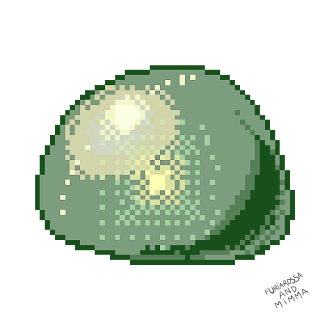 Gli aboletti (Lacrimae somniorum) sono spiriti appartenenti al gruppo dei Lemures. Nello stadio paralarvale sono conosciuti, insieme ad altre due specie della stessa famiglia (Lacrimae sanguinis e sidereum), come lacrime dei desideri.Aspetto
Gli aboletti (Lacrimae somniorum) sono spiriti appartenenti al gruppo dei Lemures. Nello stadio paralarvale sono conosciuti, insieme ad altre due specie della stessa famiglia (Lacrimae sanguinis e sidereum), come lacrime dei desideri.AspettoDa adulti, gli aboletti hanno l'aspetto di grandi masse sferiche larghe dai due ai sei metri, generalmente schiacciate ai poli, di colore verde, giallo o blu, traslucidi abbastanza da lasciar intravedere il centro d'energia luminoso, che si trova proprio al centro del corpo. Non hanno occhi ne orecchie, si orientano nel mondo solo attraverso il gusto, la percezione del dolore e quella delle vibrazioni.
La superficie degli aboletti adulti è soffice e piacevole al tatto, la sensazione di toccarli è stata talvolta descritta come simile a quella di una borsa dell'acqua calda fatta di agar agar.
Durante la loro fase paralarvale tendono ad essere più luminosi, con una superficie dall'aspetto cristallino, e a raccogliersi in piccole colonie che, quando si manifestano nel mondo materiale, sono particolarmente gradite agli esseri umani.
Quando un aboletto adulto viene ferito, si protegge formando istantaneamente sulla sua superficie una serie di lunghe spine, che gli danno l'aspetto di un riccio di mare.
ComportamentoGli aboletti sono spiriti estremamente passivi, che si limitano a rimanere nello stesso punto anche per anni, inglobando attraverso la pelle la polvere e i materiali morti che li toccano, nutrendosi molto lentamente. Sono del tutto innocui, eccetto per le lunghe spine che si formano sulla loro superficie quando vengono feriti, e per via della loro consistenza estremamente elastica e robusta sono difficili da tagliare o perforare, perciò la possibilità di essere punti per sbaglio dalle loro spine è bassissima.
Raramente si manifestano nel mondo materiale, e quando lo fanno si tratta generalmente di errori oppure è colpa di altre creature che li hanno trasportati. Quando ciò accade, non hanno alcun problema a sopravvivere nel mondo materiale, nutrendosi principalmente di polvere, foglie secche, insetti morti e altre cose che si depositano e rimangono per molto tempo su di loro.
HabitatGli aboletti sono un indicatore di zone sane e ricche di vita, prosperando principalmente all'interno di complessi ecosistemi spirituali. Generalmente si possono trovare aboletti ben sviluppati ovunque vi siano foreste viventi con alberi di grandi dimensioni.
DietaNel loro ambiente naturale, gli aboletti si nutrono principalmente di ectoplasma non-codificato e vari resti di pasti di altri spiriti. Sono eccellenti detritivori e contribuiscono a mantenere gli ecosistemi sani.
ConservazioneSi tratta purtroppo di una specie vulnerabile, cacciata dagli esseri umani come uno dei fantasmi più facili da trattenere in cattività. Purtroppo, anche se la loro immobilità li rende facili da tenere in piccoli terrari, queste creature si adattano male alla cattività, necessitando di un buon ricambio d'aria, e di condizioni variabili in fatto di umidità e temperatura: potrebbero sopravvivere facilmente in una foresta temperata, ma muoiono dopo poche settimane se vengono tenuti in ambienti chiusi.
Inoltre, il loro areale di diffusione naturale si sta progressivamente restringendo, per colpa della distruzione delle foreste, sia ectoplasmiche che naturali, e del disboscamento.
Esiste un'antica, e barbarica, pratica che consiste nel catturare i piccoli di questa specie e rinchiuderli in barattoli di vetro trasparente, esprimendo un desiderio e aspettando che le paralarve si rimpiccioliscano fino a morire di fame e scomparire, e la scomparsa della "lacrima dei desideri" in teoria dovrebbe significare che il desiderio si realizzerà. Questa insensata usanza, senza alcun fondamento magico o scientifico, ha ulteriormente ridotto il numero di esemplari di aboletto in natura.
CuriositàL'aboletto più grande mai misurato aveva un diametro di sei metri e quarantadue centimetri.Per un lungo periodo di tempo, gli aboletti non sono stati considerati esseri viventi, ma una sorta di misterioso fenomeno naturale.Sembra amare le vibrazioni prodotte dai motivetti fischiettati, una delle poche cose che possono spingere un aboletto a muoversi, e in questo caso a provare a rotolare verso la fonte del suono.
🌵🎨 Tutti i disegni di questa pagina (e probabilmente anche delle altre, se non è diversamente specificato) sono stati realizzati dalle nostre artiste, Furiarossa e Mimma! 🌵🎨
December 23, 2024
Personaggi: Sheridan Grimm
(Did you get lost, wanderer? If you're looking for this page in English, you can find it linked HERE once it's complete!)
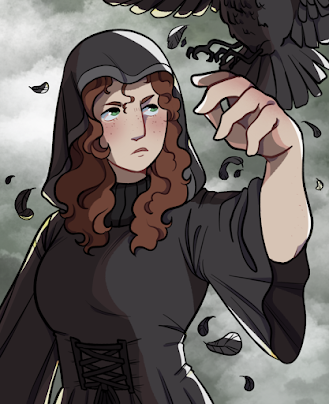 Arte di koobie
Arte di koobieNome completo: Sheridan Grimm
Specie: Umana
Pronomi preferiti: Lei/Ella.
Occupazione: Becchina, artigiana
Orientamento: Asessuale aromantica
Nazionalità: Irlandese
Peso: 132 kg
Altezza: 2,09 m
Struttura fisica: Muscolosa, in modo elegante.
Odora di: Muschio, pelle pulita, ibisco, con un tocco di ferro.
Sheridan Grimm è una Ministra Oscura che visse nel XIX secolo.
Era una donna taciturna ed autoritaria, che lavorava come becchina insieme al marito Paul Grimm in un piccolo villaggio senza nome dell'Irlanda del Sud.
Ha fatto da mentore al Ministro suo successore, il suo pupillo e figlioccio Rory Tad.
Appare nel libro, vincitore di un premio Wattys, L'Uomo dei Cimiteri parte 1 - Il Bambino.
AspettoSheridan è alta ed imponente, con i capelli rossi, ricci, gli occhi verdi. Mostra molto poco le proprie emozioni attraverso le espressioni del viso; è facile percepirla come disinteressata.
Ha la pelle pallida, spruzzata di lentiggini; la forma del viso è allungata e la mascella smussata,"a uovo".
Si veste spesso con abiti scuri e comodi, in particolare la sua mantella con cappuccio (che Sheridan tiene spesso alzato).
Ministro idealeÈ ricordata come uno dei Ministri Oscuri più performanti della storia; per quanto il potere dei Ministri Oscuri vada crescendo di generazione in generazione, e perciò tempi moderni hanno visto persone che ricoprivano il medesimo ruolo essere capaci di esercitare un potere ancora più grande, l'etica di comportamento e le capacità di Sheridan ne hanno fatto una sorta di Ministro ideale, anche e soprattutto agli occhi del Custode Oscuro.
Una strega di poche paroleLa sua forma mentis e processi mentali non si allineano spesso a quelli di un "normale" umano, e sembra del tutto disinteressata al conformarsi o comprendere gli esseri umani. Sheridan parla molto raramente, ancora una volta incurante di comunicare con gli altri o stabilire dei contatti umani. La sua voce suona bassa e metallica, quasi aggressiva.
A Sheridan piace il lavoro manuale, ed è lei a creare a mano le bare per l'attività; si comporta spesso in maniera quasi placida, senza affrettarsi per praticamente nulla, ma emana comunque un'impressione di potere in chi le sta attorno che evoca timore, quasi soffocante.
Sheridan non è capace di celare del tutto la propria natura sovrannaturale, dando l'inquietante sensazione di qualcosa di selvatico e altro negli umani che la incontrano. Le persone del paese la temono, perchè considerano Sheridan una strega ferale ed oscura, capace di grandi e spaventosi incantesimi.
E non hanno neppure tutti i torti.
Ha un'affinità particolare con gli insetti.
Le piacciono
Non le piacciono
❤ La natura
❤ L'oscurità
❤ I boschi
❤ Il lavoro manuale
❤ La quiete
❤ Un buon bagno caldo
❤ Mangiare
❤ Combattere
❤ Le poesie sulla morte 💔 I convenevoli
💔 Gli umani
💔 Perdere
💔 I braccionieri
💔 L'arroganza
💔 La Notte che Urla
Galleria di immagini (Clicca per ingrandire!)
 Con il giovane Rory
Con il giovane Rory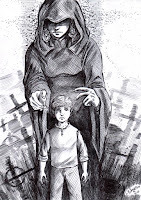 Con Rory
Con Rory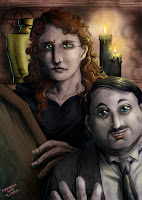 Con Paul
Con Paul
 Con Rory e Paul
Con Rory e Paul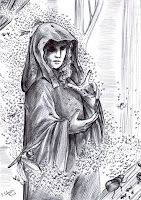
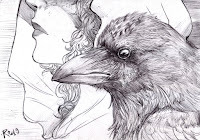 Colonna 2colonna 3🌵🎨 Tutti i disegni di questa pagina (e probabilmente anche delle altre, se non è diversamente specificato) sono stati realizzati dalle nostre artiste, Furiarossa e Mimma. Potete vedere di più del loro lavoro e supportarle sulla loro pagina di Patreon. Diventate mecenati delle arti! 🌵🎨
Colonna 2colonna 3🌵🎨 Tutti i disegni di questa pagina (e probabilmente anche delle altre, se non è diversamente specificato) sono stati realizzati dalle nostre artiste, Furiarossa e Mimma. Potete vedere di più del loro lavoro e supportarle sulla loro pagina di Patreon. Diventate mecenati delle arti! 🌵🎨
December 22, 2024
Mangiacalzini
I mangiacalzini (Nigris sublecto) sono spiriti di dimensioni medio-piccole, appartenenti alla famiglia dei Lemures. Sono spiriti sinantropi, molto comuni all'interno delle case degli umani che abitano in America del Nord.
Il nome scientifico di questa creatura, Nigris sublecto, si riferisce alla loro abitudine a nascondersi in posti bui e angusti, come ad esempio sotto i letti. Il nome comune della creatura, mangiacalzini, si riferisce invece al fatto che spesso rubano le calze degli esseri umani per farsi un nido, composto da una pila di oggetti morbidi (fra cui, ovviamente, i favoriti sono i calzini) sotto cui nascondersi. Contrariamente a quello che si pensava in tempi più antichi, i mangiacalzini non si nutrono di calze, né di alcun altro capo di abbigliamento.
I mangiacalzini, una volta raggiunta l'età adulta, sono lunghi dai quarantacinque centimetri ai due metri. Hanno un corpo lungo e affusolato, serpentino, e dal loro collo si diparte una raggiera di tentacoli che hanno più o meno la lunghezza del corpo, dando l'impressione che la creatura sia composta solo da una piccola testa e da un groviglio di lunghi tentacoli. Il colore della loro pelle è interamente nero.
Appartenendo alla famiglia Nigris, gli scienziati dibattono sul fatto che i tentacoli siano in realtà code, come quelle che compongono i finti tentacoli dei loro più piccoli cugini, i wuppi, e fino ad ora le ricerche sembrano puntare in quella direzione: non avendo un apparato scheletrico, ed essendo la loro anatomia estremamente differente da quella degli animali del mondo fisico, non è implausibile che le code multiple siano "risalite", in anni di evoluzione, fino al collo.
I mangiacalzini non hanno occhi visibili, essendo questi sempre protetti da uno strato di pelle, e sono molto miopi: fondamentalmente utilizzano gli occhi solo per individuare le fonti di luce e il movimento di grossi oggetti, da cui tendono a scappare.
La loro testa, dai contorni molto smussati, è leggermente schiacciata e caratterizzata da una bocca ampia, piena di denti affilati e triangolari. Sulla cima della testa, spuntano due piccole antenne semi-rigide, con le quali possono percepire i cambiamenti nel campo elettromagnetico e comunicare fra di loro.
Al contrario della maggior parte degli altri lemures della famiglia Nigris, i mangiacalzini adorano manifestarsi nel mondo materiale: sono infatti in grado di metabolizzare la forza vitale, ed in seguito, quando i loro corpi si sono completamente materializzati ed adattati, le proteine che prendono dalle loro piccole prede. Quando un mangiacalzini è interamente materializzato, diventa molto denso e pesante per la sua taglia, arrivando a pesare in casi eccezionali fino a quarantacinque chili.
Normalmente sono molto timidi, ma è possibile per un essere umano addomesticarli e persino addestrarli, per via della loro spiccata intelligenza. Il meccanismo è semplice: guidati solo dal loro istinto, i mangiacalzini accetteranno volentieri di compiere piccole azioni, di obbedire a certi comandi, in cambio di bocconcini di cibo delizioso.
Bisogna però stare molto attenti: anche se un mangiacalzini si è abituato alla presenza di un essere umano, non significa che accetterà chiunque nel suo territorio, e se viene costretto contro la sua volontà ad interazioni con altre persone che non conosce, senza avere una via di fuga, può attaccare e ferire gravemente anche un umano adulto, grazie ai suoi denti affilati e alla forza prodigiosa dei suoi tentacoli.
La riproduzione avviene sempre nel mondo spirituale, essendo i neonati troppo deboli per manifestarsi nel mondo fisico; i piccoli migreranno nella loro nuova casa solo una volta che saranno divenuti capaci di assumere forme pseudo-materiali.
I mangiacalzini amano gli ambienti umidi, ricchi di materiale in decomposizione, che attirino molti piccoli animali, ma si accontentano di stanze asciutte e pulite, se riescono a trovare altri modi per procurarsi il cibo.
I mangiacalzini domestici hanno una dieta generalmente più varia e bilanciata, con il risultato di essere in migliore stato di salute.
December 20, 2024
Aurolupus lycans
Also known as Goldenwolfen, the Aurolupus are a kind of canine/primate shapeshifters very often confused with the real lycans (Homolupus homolupus) or with the werewolves (Lupus hominarium), but capable of hybridizing with both. They are extremely rare and dangerous, therefore it is advisable not to approach one (in particular if you do not have experience with lycans or werewolves) and, if you encounter them in your zone, to denounce their presence to the competent authorities.
A reminder for the magic users, that these creatures are completely immune to magic both outside and inside their body and therefore that your powers, however developed, can't in any way kill them nor retain them. Due to their incredible bone and muscle density, bullets too may not be decisive in their killing.
 Origins
Origins The most probable ancestor of aurolupus beasts is the Xenocyon Lycaonoides, a large canid that lived in the Pleistocene, between 1.8 million years and 30,000 years ago, which feed on antelopes, deers, elephants, wild horses and probably also men.
It is assumed that the Xenocyon have crossed with a primitive "prototype" of lycanthrope and thus acquired the ability to change, albeit in a rough way.
Over time, the aurolupus has refined its mutation skills, although modernly they still do not love to acquire and maintain a humanoid form.
According to some scholars that specialize in the study of this primitive species of shapeshifters, the fairer fur that some specimens show is the result of the interbreeding with the extinct species of lycans known as white terror (Homolupus terribilis), from which modern aurolupuses have inherited not only some shades of their fur, but apparently also greater mental instability and greater aggression than that of their Xenocion ancestors.
Another species that seems to have contributed to the creation of the modern genetic heritage of the aurolupus is the unfortunately recently extinct small African werewolf (Lupus hominarium africanus), from which it seems that they inherited the ability to be totally refractory to all kinds of magic.
However, some researchers argue that the aurolupus have become refractory to magic at the beginning of their evolution due to a spontaneous genetic mutation and not because of the intersection with the small African werewolf.
The first complete standard of the species and its breeds was officially established by the CPF (Company for the protection of the forms) on 18 December 1898 and was reworked again and catalogued in 1980.
AppearanceGeneral characters: the aurolupus or goldenwolfen is shapeshifter werewolf-type of medium-large size, with light fur, strong and muscular, heavy skeleton and solid structure.
Everything in their figure must give an idea of rough strength and must strike fear in the heart of the enemies. The ears are erected.
It is distinct in three different types: supergoldenwolfen (giant), goldenwolfen (medium) and splinter (small).
The most common and functional type is the goldenwolfen (medium), the smallest and more rare are the splinters, while the supergoldenwolfen are considered practically legendary.
Fundamental measures
the aurolupus has four different forms of transformation, in order of height to the shoulder: feral, native, human and fullmoon.
Supergoldenwolfen (giant size)
Feral (lupine type): prefer the females between 70 and 88 centimeters at the withers, males between 71 and 93 centimeters at the withers. The minimum required height is 70 centimeters, there is no maximum height.
Native (hyena/wolf of caves-like type): preferred height for females between 89 and 150 centimeters at the withers, preferred height for males between 94 and 160 centimeters at the withers. Interestingly, in the aurolupus supergoldenwolfen, the native form can grow at much greater heights, but only temporarily, depending on how much they have nourished before their transformation.
Human (humanoid type): minimum height of 1.85 m, maximum of 2.22 m for both males and females.
Fullmoon (anthropomorphic body, covered in fur type): minimum height of 1.90 m and maximum of 2.50, both for males and females. A margin of -2 centimeters is tolerated for females with optimal proportions and +2 centimeters for males that display optimal proportions.
 A blind supergoldenwolfen male in native form
A blind supergoldenwolfen male in native formGoldenwolfen (medium size)

Feral (lupine type): females between 63 and 72 centimeters at the withers, males between 63 and 74 centimeters at the withers.
Native (hyena/wolf of caves-like type): preferred height for females between 89 and 120 centimeters at the withers, preferred height for males between 90 and 140 centimeters at the withers.
Human (humanoid type): minimum height of 1.68 m, maximum of 1.82 m for both males and females.
Fullmoon (anthropomorphic body, covered in fur type): minimum height of 1.80 m and maximum of 1.97, both for males and females. A margin of -2 centimeters is tolerated for females with optimal proportions and +2 centimeters for males with optimal proportions.
Splinter (small size)
Feral (lupine type): females between 60 and 64 centimeters at the withers, males between 63 and 70 centimeters at the withers.
Native (hyena/wolf of caves-like type): preferred height for females between 70 and 110 centimeters at the withers, preferred height for males between 75 and 115 centimeters at the withers.
Human (humanoid type): minimum height of 1.50 m, maximum of 1.78 m for both males and females. Full moon (wolf/humanoid type): minimum height of 1.80 m and maximum of 1.97, both for males and females. A margin of -2 centimeters is tolerated for females with optimal proportions and +2 centimeters for males with optimal proportions.
The full moon size of this breed is identical to that of the average race, having an incredible expansion capacity (although, of course, remaining much lighter).
General appearance
Head: the head is in the shape of a cone, powerful and about 45% of the height at the withers, on average wide between the ears. The skull-muzzle ratio is 50%-50% in lupus form. The jaws, upper and lower, are extremely robust and remember those of an hyena. The nasal bridge is rectilinear, with a wide base that is decreasing moderately in width from the background towards the forward. The lips are strongly pigmented, from brown to black, well stretched.
Powerful and complete teeth (42 teeth). The upper incisors are scissor on those of the lower jaw. Sometimes the upper canines are so long that they protrude outside the mouth. The teeth are almost never completely white, more often than a light yellowish color. The tongue is covered with filiform papillae, curved and forming a hard hook towards the throat, the function of which is to allow the animal to have a stronger adhesion to the things that it's heating, also allowing it to scrape deeper the bones of the prey captured. The zygomatic arches are well marked and a powerful bone structure must be noticed with a single look. The eyes are of medium size, round, golden or ocher color, that can become brown in human form. Never blue or gray, in a pure specimen. The ears are from medium to small in size. In all feral (non-human) forms they are triangular, very spaced from each other and attached high, turned forward, without hair inside.
Neck: powerful, long, very muscular and with a slightly arched superior profile. It is adherent, always free of dewlap or loose skin round the throat.
Body: Powerful back; The rump is wide, of medium length, inclined by about 23 ° on the horizontal in the lupine form. In the native form, the back line descends inclined by the "hump" of muscles and fat on the shoulders until the rear that is low.The chest is spacious, wide and well descended, with well-developed muscle and strong, long ribs with a very curved shape, creating a strong torso shape.
In human form they often give the impression of working a lot on the development of the torso musculature, although the latter is almost never defined.
The lines of the body are often defined as more similar to those of hyaenides than canids.
Tail: in the natural state it is brought horizontally as an extension of the back line, it is hanging at rest. It is thick, from medium-short to short, very well muscled, and give to the beast's silhouette a primitive aspect.
Limbs: long and well articulated in human and fullmoon form, average length in lupus, and muscular form in a native form. The thigh is always of medium length, wide and strongly muscular. It may happen that the goldenwolfen have long arms in proportion to those of a human being of equal height. The feet have strong, arched and well closed fingers. In native and fullmoon form they have long curved and highly pigmented nails, of an array of colors that can go from the light gray to black, passing from various brown shades.
The pawpads are dark pink, olive or brown in color.
Gait: naturally brought to the trot, they have a powerful pace with good extension. Often, due to their proportions and the way they move their feet, aurolupuses seem clumsy: nothing further from reality, since these creatures are very agile (except in the fullmoon form, where the muscles change structure and are connected on bones and cartilage in order to have great power, but little agility and looseness) and capable of sudden direction changes.
Skin and fur: the skin is never very fair and the most common color is the olive, immediately followed by the "spotted" (brown leather with extensive olive patches). In rare cases the skin can be entirely brown. Among the supergoldenwolfen it is common that the skin is a little lighter than their similar and medium-sized fellows, but even in this case they are never pale.The hair and fur is dense, hard, straight with admitted rare traces of undulating. On the face, on the feet and palms the hair is very short; The dominant males are the exception that exhibit a thick beard on the chin and throughout the lower jaw line, only sometimes accompanied by mustache.The length of the mane and hair on the tail and back defines the social role within a pack and is closely related to hormonal production: the higher the rank of a specimen, the long the mane will be. In addition, males generally have a little longer mane than females.Ideally we can say that the most hairy specimen will be the male alpha and the one with the finest and short hair will be the female omega.Aurolupuses have no undercoat and therefore suffer the cold.
The colors admitted for the mantle are: honey with red-brown, brown or light gray patches, single-colored honey, single-color gilded, golden with brown/black dorsal strip, light gray with saddle and golden mask, Isabella (cloak that derives from the cream gene, which dilutes the yellow, gold and brown colors, leaving the black of legs and muzzle unchanged), sand, sand with mane brown, ocher with brown brands, yellow merle.
It is possible, although very rare, to meet specimens of a gold color so light that they seem almost white, but these are often very penalized, compared to their more intensely colored brothers, being more delicate, easily spotted by preys and in general not chosen by partners for mating.
 All possible fur colors
All possible fur colorsBehavior
Nevrile, reactive, prone to biting, the aurolupus has a character difficult to manage by a non-expert and even the most expert could have a bad time: they are definitively animals that have nothing domestic and therefore is heavily advised against any attempts to domestication by whoever.
Normally they live in heavily hierarchized packs and love to fight. It is one of the few species with real "expansionist aims", willing to attack and kill other pack, even of their same species, in order to take their territories, even when they have no need for them. The rarity of this species is mainly due to the ease with which different packs collide and kill each other.
The very known rule of the lycans, for which they themselves should never reveal their existence to human beings, is one of those rules to which the Aurolupus do not give any weight, actively chasing men and women, who are among their favorite prey.

Communication
Extremely communicative, the aurolupus speak their own exclusive language, the Garou of the Children of the Sands (Gogroorawleefaaa off) of which they are able to pronounce the phonemes in any form, including the feral one. When they try to speak any human language (which are usually able to do only when they have assumed a completely humanoid form) their accent seems a strange mixture of German and Spanish.
To be talked about in a correct way, the Garou of the Children of the Sands also requires a particular body mimicry. The same sentence, accompanied by different gestures, can also have opposite meanings.
Courtship and reproductionAurolupus reproduce once a year, in spring, when females (only in the presence of males that stimulate their interest) go into heat. Both males and females are polygamous and the same litter can belong up to three different fathers. Dominating males submit those of lower rank by mounting them and, if someone rebels, the situation can lead to terrible fights in which males show off all their athletic qualities and their strength to impress females.It is always and only the females who decide who to mate with, but it is almost certain that they will always choose the most violent male, the one that has inflicted the greatest number of humiliations and wounds to the other males of the same pack (or even of different packs), since violence excite them sexually.
Approaching a pack of Aurolupus during the reproductive period is a bad idea, especially if you are male: the males of the pack try to submit specimens of their own sex of almost any other species. Even females sometimes fight with other females for the privilege of mating first, or in some cases several times, with the alpha male.
The alpha female always has the right of choice on any male, and mates first of all the others, also rarely fights, because when she does it the objective is to kill, not to just injure.
The males are not kind during mating, and so the females, with the result that many close couplings can debilit a specimen.
The gestation lasts about three months, at the end of which the puppies are born on the open ground or in a cave, depending on where the pack has settled in that period and atmospheric time. The blind and deaf puppies are cared for very little by the mother (who breastfeeds them only, between one hunting session and the other) or by the father, but generally remain throughout their time with the nanny of the pack, a specimen (of sex independently male or female) who has the role of protecting all the little ones of the pack and does it with commendable ferocity towards enemies and tenderness towards the puppies, who warms, cleans and instructs.

Religion
Deeply animists, they do not believe that divinities are purely spiritual beings and have an interesting pantheon of creatures that manifest themselves through natural phenomena, such as thunder or fire. The most powerful of their divinities, to whom they offer human and cattle sacrifices alike, is the Great Wolf of Sand, born from a storm in the desert, which is considered the mother of all the aurolupuses, who are not considered created by the same deities they have created other animals.
Their shamans thus summarize the vision of their people:“Humans are children of the mud, with a heart of mud and an air soul. The werewolves were born from the flesh of the wolves and have a heart of meat and spirit of shadows. Vampires were born from the flesh of the dead, have a heart of ice and have no spirit. We are children of the sand, with a heart of meat, and our spirit, like that of dragons, is flaming and immense, terrifying. We have been created to dominate on any other hunting or non-hunting species".
According to their religion, all lives have the same value, except those of the aurolupus, which are worth much more.
Famous aurolupuses:
BlindfuryHerzeleid Furiadoro (Daughter of Blindfury)Alejandro Roberto De Rocamora (Son on Blindfury)Sara Barker
TriviaAurolupus specimens have the extraordinary ability to be completely refractory to magic. The thing that frightens the aurolupuses most (and someone could object by saying that it is the only thing capable of frightening them in general) is the fire, that they fear and worship, declaring that it is the substance of which their souls are made. A forest fire can literally paralyze an entire pack of fear. During the full moon they become so aggressive that they cannot control the impulse of fighting, despite being lucid. The next morning, they remember exactly everything they have done, unlike how it happens with many lycans and especially with uncontrolled ones. It is very rare to find hybrids between the aurolupuses and other species of lycanthropes, not because they do not mate with them too, but because they almost always kill them during the mating process. The saliva of the aurolupuses contains bacterial charges which can often be lethal for a human being.

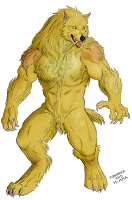
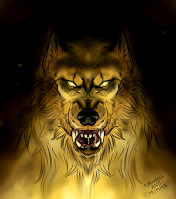
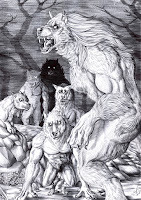

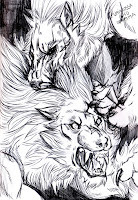
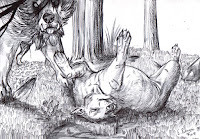
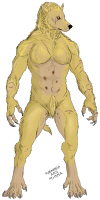

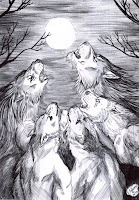

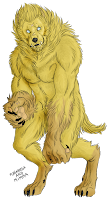
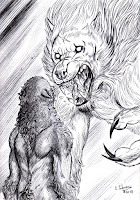


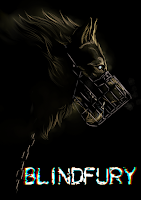



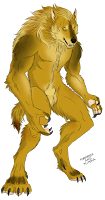

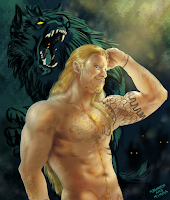

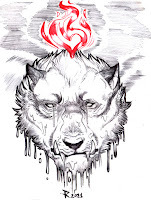
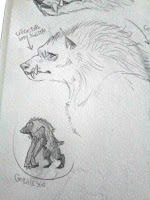
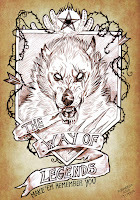
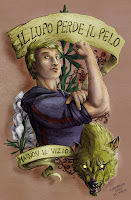
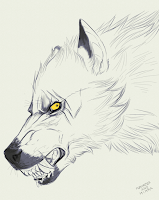

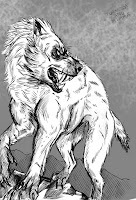


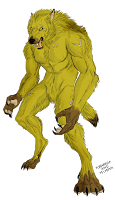


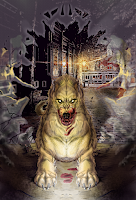
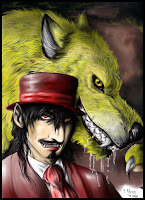
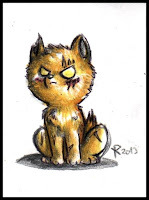
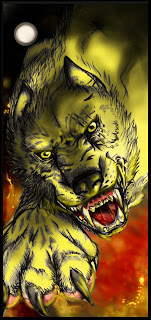
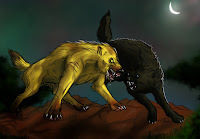 Colonna 2colonna 3Colonna 1Colonna 2colonna 3
Colonna 2colonna 3Colonna 1Colonna 2colonna 3
🌵🎨All the drawings in this page (and probably in all the other pages, if not differently specified) were realized by our artists, Furiarossa e Mimma. You can see more of their work on other sites too! 🌵🎨
December 17, 2024
Filastrocca - Poltergatto
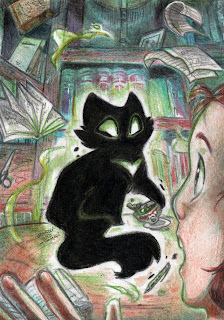 Abbiamo in famiglia
Abbiamo in famigliaUn animaletto
Che quando gli piglia
Fa un bel dispetto
Stanza a soqquadro
Lenzuola disfatte
Vola via un quadro
La porta sbatte
Dal comodino
Vuole buttare
Il mio cellulare
Colto nell'atto
Del suo misfatto
Spirito micio
NO, Poltergatto!
Tutti i disegni in questa pagina (e molto probabilmente anche in tutte le altre pagine, se non diversamente specificato) sono stati realizzati dalle nostre artiste, Furiarossa e Mimma. Potete vedere altri loro lavori e/o supportarle (e supportare così anche tutti i Cactus di Fuoco ;)) sulla loro pagina Patreon. Diventate patroni delle arti!
December 13, 2024
Black Duckling
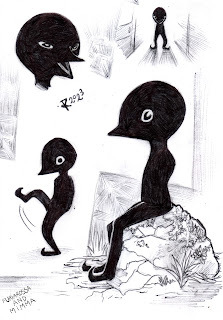
The Black Duckling is a mysterious fae (most likely a subspecies), whose apparition is considered by some a symbol of good luck, by others an inauspicious omen. To date, it is not known whether it is a single specimen or an entire species, since two have never been seen at the same time.Origins
The origin of this species is largely unknown.
Some experts believe that these are a subspecies or a direct evolution of the Pwca, others deny each connection between these two species. Almost certainly it is a recent Fae, no longer older than a thousand years.
A theory that is taking hold is the one for which in reality the Black Duckling does not belong to any species, but it is a unique and new mutation of some type of fairy that has not yet reproduced, and therefore is an absolutely unique specimen with characteristics not found in any other fae or spirit.
AppearanceAs the name suggests, the Black Duckling has something in common with the ducks, which immediately identifies it: the beak, relatively short, and the pace, on two legs that end, however, not on their feet palmated, but in those that seem to be small shoes with curled tip.
It is not known if the Black Duckling wears clothing or if it’s naked and his body is just entirely pitch black.
His typical walk is funny and slightly clumsy, with the knees that get up a lot at every step, giving the impression that it is a tiny child who has not learned very well how to walk yet.
Due to its uniform black color, with the white of the eyes that stands out against the mantle and the absence of details and limbs that protrude (except the legs), some people find the appearance of this creature particularly unsettling, almost frightening, describing it "as if this were an almost completely burnt beast".
Its voice is subtle and nasal, described by some as "ducky", but testimonies (especially the ancient ones) believe this creature capable of emitting very acute blood-freezing screams.
BehaviorThe Black Duckling is generally silent, moves without emitting sounds and tends not to communicate verbally, although it is capable of it. When it communicates verbally, it seems able to speak whatever is the language of the person with whom he wishes to communicate: so far there are testimonies of the Black Duckling that speaks in German, American English, ancient English, French, Scottish, Gaelic and Italian.
TriviaDespite the funny and clumsy walk, the Black Duckling is capable of running at a maximum speed of ninety kilometers per hour.
They say that dreaming of the Black Duckling means that a great cold is about to arrive.
According to some texts, the Black Duckling appears to people who suffer from some incurable evil, but if it is sent away from the patient, the disease will also take away, miraculously healing those who have driven it out.
Legendary Dogs
Legendary dogs
Legendary dogs are not animals like us: they transcend the laws of genetics and magic to show themselves as completely different beings from normal meat beings. Halfway between the hounds of shadow and the common dogs, they are able to untie from normal magical mechanisms and to control the elements. However, these are not elemental spirits (nor, in general, spirits), as one might think of their close union with the magic of this type, but of meat creatures.
Many have tried to steal the profound secrets of this species, but the studies on them have not solved that superficial puzzles and legendary dogs are still surrounded by a often coat of mystery. However, saying that it is a species in this case is particularly reductive as well as incorrect: legendary dogs are not a kind or a race, but rather a particular group of magical creatures with common characteristics, therefore they do not share a scientific name and not they can reproduce with each other.
OriginsLegendary dogs are born in the mid-eighteenth century, from some magigenetic experiments of a group of Irish manufacturers Druids whose names are not known, but according to some it is a history invented by healthy plan to cover the macabre attempts to create an animal defender Perfect by Paulus Grimorius, the black custodian of the Ministry of Darkness.
Starting from simple dogs (Canis Lupus Familiaris), thanks to the help of a particular type of organic magic, some innate genetic characteristics were overcome in order to create super-men.
Not all specimens have the necessary characteristics to be changed in legendary dogs, therefore the subjects must be chosen with extreme attention. Subsequently, the technique for the creation of legendary dogs was also shared with the Ministry of Light (following the declaration and unification of techniques for the creation of new species, in 1890) which however rarely uses it and historically less than 1% of legendary dogs was created by the Ministry of Light.
Basic characteristicsLegendary dogs, as already mentioned, are all strongly different from each other, but have some characteristics that make them immediately recognizable.
Compared to the races of origin, they are increasingly large. The growth and height growth compared to the original body can be between 16% and 110%, depending on the specimen and its natural potential. Some legendary dogs are really huge, with a weight that exceeds one hundred kilos, and could in no way be exchanged for common dogs.
They have a marked propensity to elemental magic, so they can often produce the element akin (for example, to create electricity through the cloak or spit fire). There are no non-magic legendary dogs.
There are no legendary anurious dogs (without tail). Even if the dog's basic body has undergone an amputation, after the transformation it will always grow back.
They are all capable of mentally communicating between them and with human beings, although with different degrees of intelligence.
They have a greatly longer life than those of dogs and also humans. In fact, to date no legendary dog has died of old age.
Their tapetum lucidum emanates light when the creature uses a massive quantity of magic, as this also passes through the reflective layer immediately behind the retina, thus making their eyes shine. The color of light varies according to the genre of elemental magic to which the dog is linked.
Then there are some characters that can spontaneously manifest themselves in some specimens, but which are obviously not shared by all legendary dogs. Here are some of the best known:
The blue mantle. Although it is a very rare feature even among legendary dogs, a part of them, and only if they originally have the white or honey-colored fur, can it show a change of color to become blue or blue, both whole and in spots. In both cases we speak of "blue mantle"
Non-chaninity. Some legendary dogs change aspect so radically not to seem more dogs, coming to look more like bears or lions. Very often this feature coincides with a hair elongation.
Human voice. Almost 40% of legendary dogs manage to develop a complex vocal ropes system that allows them to speak. However, not all legendary dogs that have the "human voice" are intelligent enough to formulate phrases of complete meaning.
High intellectual quotient. Almost 16% of legendary dogs have a much higher intellectual quotient than dogs and most human beings. When this gift is combined with the "human voice", they can speak, otherwise they use mental communication to express themselves.
Horn. Almost 30% of legendary dogs have horns of some kind. The most common are those of ram, but it is possible, although rare, that they develop horns similar to those of bulls or gazelles. They usually have a dark color and are always accompanied by a particular development of the skull, with particular strengthening of the forehead.
The boltning. The creature coat, especially if rough, often develops a particular design called "boltning": long strips, similar in shape to bolts and dark in color along their hips and back.
Supernatural speed. Some legendary dogs are capable of moving more quickly than a Greyhound greyhound, despite the imposing size. It seems that this feature is strongly linked to the blue coat.
ReproductionLegendary dogs are considered sterile, although in -depth research has never been done, and it is believed that they cannot be born except through a particular process of magical creation whose "ingredients" are very secret, but that concerns the use of at least a normal dog.
Forging and loyaltyLike the dogs from which they descend, even legendary dogs have a proverbial loyalty, not so much to a master as for the task that was entrusted to him during the process called "forging", the transformation from dog to legendary dog.
In poor terms, it could be said that these creatures are "scheduled" for a specific action, whether it is protecting a treasure or a person, and they are ready to die not to betray their ultimate purpose. If the person who protects dies, or the treasure is stolen, the dog almost always returns from his creator, who can proceed with a second forging to give him a new purpose in life.
It is impossible to implement a second forging if the dog's previous task has not been completed or has not failed: a dog who is still protecting a living person or a treasure stroke will remain to do so forever and there is no magic that can distract them from this task.
The second forging will not only give a purpose to the dog, but will further change its appearance, partially adapting it to its new task. A legendary do to whom no mission has been entrusted during the moment of the forging is called insanus and will follow only his instincts, becoming highly unstable.
Cemetery grims or legendary dogs?There are countless magical creatures with a canine shape, but those that are most often confused with legendary dogs are the grams of black cemeteries or dogs.
The cemetery grims (or black shucks) are described as supernatural beings larger than a wolf, with flaming red eyes and the black hirsute fur, but sometimes phosphorescent, who live near or even inside cemeteries. Furthermore, often we talk about the grams as a shapeshifter, capable of resembling human beings, and they are associated with death and darkness.
The legendary dogs, although they are also resembling large and terrible canids, can never be transformed into human beings, do not have powers intrinsically related to darkness and never have the entirely black fur.
So if you find yourself in front of a huge, monstrous magical dog with sparkling eyes, you just need to make sure that their fur is not completely black to distinguish a cemetery grim from a legendary dog.
The mystery of the three guardians of the Stone of SourcesAlthough it is known that legendary dogs can exist only if created and that the first ones have appeared in the mid-eighteenth century, there is a particular case that is cloaked in mystery.
In guard of the Stone of the Sources, in India, for a long time (the legends tell of five hundred years) three beings were placed, completely similar to legendary dogs, whose origin is still unknown today.
Who created these dogs? Is it an extraordinary phenomenon of natural magic or had someone actually discovered how to create legendary dogs long before the eighteenth century?

Orion, Galvatrike and Sherre, as they were called, were tenacious creatures with the appearance of predatory mammals, reported in the texts just as "legendary dogs".
And it is precisely because of their denomination that modern manipulated magigenetically manipulated canids are called legendary dogs.
Orion, intelligent as a human being, was guarding the external perimeter.
Galvatrike, the only female of the trio as well as the strongest physically, had the task of protecting the median circle and an aspect that strongly remembered that of a pitbull.
Finally, with the task of protecting the stone, there was Sherre, a splendid creature with a blue mantle that owned the gift to control the air generating impetuous currents. Any attempt to study the magical trio was found in nothing or even in the death of the researcher.
After the theft of the stone of the sources of which they were guarding there were no more sightings of these anachronistic legendary dogs.
“The path is insidious, the tortuous way
The stone of Sources does not wait for men.
In the heart of the forest you will face every beast
The three legendary dogs guarding the treasure
In the center of the shadows, where the darkness bursts,
The heart of the middle ground palpitates
Promised land of water and winds
Which will erect barriers at any cost
To preserve its ancient secret that never human soul dared to touch
Immense power of hurricane, storm, waterfall,
source of all sweetness that keeps the world alive "
- Scontramondi (I - the Stone of Sources)
Ever since they know each other, legendary dogs have always been used as guardians or messengers by the Ministry of Darkness. The favorite specimens are the high ones, dark in color and which almost always present boltning on the hips; they’re obtained transforming deerhounds (Scottish Greyhounds) and Irish Wolfhounds into legendary dogs. A unique peculiarity is that they, on the night of Halloween, are "freed" for all the hours of darkness, left free to do what they want without repercussions: even killing a human being or that destroy precious artifacts would not matter, the druids of the ministry would not punish the dog in any way.
Generally legendary dogs act under direct order of the Queen or Black custodian, always separately by the Dark Minister, although in extreme cases they can collaborate to defeat too strong enemies.
Furthermore, Dark Ministers have the task of stopping and putting to sleep every insanus when they become dangerous.
The most famous of the legendary dogs of the Ministry of Darkness, also considered the "alpha" of these mysterious and very rapid emissaries, is Lucifer, a legendary dog transformed starting from the Irish Wolfhound that had belonged to the dark minister Rory Tad, when he was still a child.
LimitationsSome breeds of dogs do not have any of the genetic characteristics necessary to have changed in legendary dogs and among them we remember in particular the Dobermann, the Dalmatian, the Broholmer and the German tolan. No wolf can be changed in a legendary dog.



